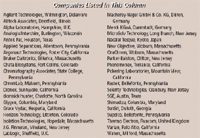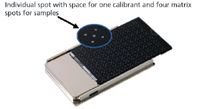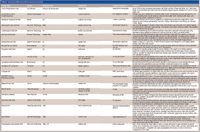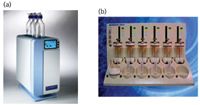New Chromatography Columns and Accessories at the 2005 Pittcon Conference: Part II
LCGC North America
This month's installment of "Column Watch" is the conclusion of a two-part series in which Ron Majors examines the trends in column introductions at Pittcon 2005. Here, he discusses gas chromatography columns, sample preparation products, hardware, and accessories.
Pittcon 2005 — the 56th Pittsburgh Conference on Analytical Chemistry and Applied Spectroscopy — ended its stay at Orlando's Orange County Convention Center in Orlando, Florida last month. The Pittcon organizing committee reported that more than 21,000 visitors came to see approximately 900 instrument manufacturers and 1aboratory suppliers in approximately 2500 booths. In addition to attending the exposition, the conferees listened to nearly 1000 oral presentations, viewed hundreds of posters, checked out one of the dozens of seminar rooms, or attended one of 130 short courses. Clearly, Pittcon is still the most important yearly international analytical exhibition, where companies introduce their latest instruments, instrument accessories, columns, sample preparation products, and other consumable products.

Ronald E. Majors
The purpose of this report is to provide information about many of the new separation consumables and accessory products that were displayed at Pittcon 2005. In some cases, products that were introduced during 2004 but after Pittcon 2004 could be included for reasons of completeness. The information is based upon manufacturers' responses to a questionnaire mailed in December 2004. Because of space limitations and the fact that some of the manufacturers did not respond to the questionnaire, this report cannot be considered an exhaustive listing of all new products that were introduced in Orlando.
As in previous years, columns and other products recommended by their manufacturers primarily for biomolecule separations or sample preparation are denoted in the tables with the designation BIO. Some of these products can be used for general high performance liquid chromatography (HPLC) separations as well, but their main emphasis is on biological samples. I cite specific information about bioapplications where appropriate.
In last month's column, I described new columns for high performance liquid, reversed-phase, normal- and bonded-phase, ion-exchange- and ion, size-exclusion, and specialty chromatography (1). This month, I will look at gas chromatography (GC) columns, sample preparation products, hardware, accessories, and kits for chromatography and sample preparation.
GC Columns
Although GC is considered to be a relatively mature separation technique, new GC columns continue to be introduced each year at Pittcon (Table I). This year, Shimadzu (Columbia, Maryland) introduced a full line of capillary columns to go with their instruments. An impressive 625 new part numbers of regular and specialty capillary columns and guard columns were added to their portfolio. A new line of GC capillary columns also was introduced by Chromatography Associates (State College, Pennsylvania).

Table I: Gas chromatography columns
In recent years, there has been a trend in the introduction of ultralow bleed stationary phases that allow better detection limits, less baseline drift during temperature-programmed separations, and improved compatibility with GC–MS analyses. This year, four companies, Agilent Technologies (Palo Alto, California), Phenomenex (Torrance, California), Thermo Electron (Bellefonte, Pennsylvania), and Varian (Middelburg, The Netherlands), introduced new capillary columns with greatly improved bleed specifications compared to previous versions. Capillary columns with internal diameters ranging from 0.10 mm (small bore) to 0.53 mm (large bore or megabore) were the most popular sizes. This year, most introductions were wall-coated open tubular (WCOT) columns.

Companies Listed in This Column
All of the general-purpose GC capillary columns displayed at Pittcon 2005 were crosslinked phases. Crosslinked, chemically bonded, or immobilized phases are more stable, have lower bleed, and usually can operate at higher temperatures than coated phases. Another advantage of the bonded phases is their ability to be solvent-rinsed. If a column becomes contaminated by high boilers, inorganic compounds, and other nonvolatile impurities that can cause drifting baselines, bleed, and other undesirable occurrences, it can be disconnected, washed (outlet to inlet direction) with various solvents, and placed back into the gas chromatograph for further use.
Applications-specific columns always are popular introductions at the Exposition. Columns for PONA, chiral compounds, purgeable organics, PAHs and other semivolatiles, organophosphorus and other pesticides, and PCB congeners were among those classes of compounds mentioned. Many columns are pretested and are shipped with test chromatograms.

Table II: Sample preparation products
Sample Preparation Products
As indicated in Table II, Pittcon 2005 was another productive year with 21 new sample preparation products or families of products displayed. Among the more popular introductions were products to deal with increasingly smaller amounts of available sample. Such products as solid-phase extraction (SPE) and filtration-pipette tips, trapping columns for proteomics, and miniaturized versions of dialysis membranes and immobilized enzyme packings for protein degradation fitted into this category.

Table II: Sample preparation products, continued
In the last several years, the 96-well SPE- and filter-plate designs have proliferated, driven by the needs of high-throughput sample preparation automation requirements. This year, the number of these products was down from last year. A 48-well plate with larger volume wells compared with the 96-well plates was introduced. Such a plate is more useful for trace analysis, in which the typical 1–2 mL well volume is not sufficient. The footprint of both types of plates is the same. A very high surface area (1500 m2/g) polystyrene–divinylbenzene (PS-DVB) SPE product introduced by Analogix/Interchim (Burlington, Wisconsin) was reported to have an extremely high loading capacity. Argonaut Technologies (Redwood City, California) added a protein precipitation plate with dual frits, one of which was a depth filter. The other frit was functionalized and permitted the organic precipitation solvent to be held up so that it could be added first before the plasma sample. The purpose of the depth filter was to retain the precipitated protein without well blockage. The experiment is depicted in Figure 1. The company reported an increased recovery of drugs from human plasma at the 10 ng to 100 μL concentration level compared with the "plasma first" method of protein precipitation, as well as a greater amount of protein removal. Cleaner extracts allow less ion suppression in LC–MS and better sensitivity.

Figure 1: Principle of Solvent-First protein precipitation plate (courtesy of Argonaut Technologies).
An alternative approach also suited to automation is the SPE pipette tip. In this design, a small amount of packing material is held either in the tip by frits, inserted as a plug of monolith packing, or coated on the inside of the tip to allow easier passage of fluid. This design has proven useful for desalting small amounts of protein and other biological samples for study by LC–MS. This year, filtration pipette tips were added to the mix. A miniaturized dual-mechanism pipette tip design included a molecular weight cutoff filter that prevented large proteins from entering the tip while small molecules could pass through and interact with various sorbents. Another tip contained an immobilized enzyme such as trypsin that could be used to digest very small amounts of protein to aid in their structure determination by LC–MS-MS.
In proteomics studies, tiny amounts of protein-containing samples from cells and other biological forms are investigated in attempts to relate minor up-regulated or down-regulated proteins to disease states for diagnostics purposes and other uses. Much of this work is being done by on-line techniques such as 2-D HPLC coupled with MS. Because the amount of intact protein or digested protein is very small, some concentration is needed before the chromatography. Small trapping columns packed with ion-exchange, affinity-, or reversed-phase packing material are used for this purpose. In addition, samples often contain large amounts of salt that can come from the sample itself or from elution buffers. Capillary- and nano-sized trapping columns also can be used to desalt these samples. Several companies introduced trapping columns for these on-line cleanups and enrichment.
MALDI-TOF MS has become an indispensable tool in addressing challenging peptide identification problems in proteomics. To go with their new Autoflex II MALDI-TOF–TOF system, Bruker-Daltronics (Billerica, Massachusetts) introduced their Prespotted AnchorChip, which is a disposable,, polymer-based MALDI target in industry-standard microtiter plate (MTP) format prepared with 96 calibration spots and prespotted with HCCA matrix for 384 samples. This new bar-coded format, shown in Figure 2, provides exactly positioned samples on the target and eliminates cross contamination from previous samples and calibration spot preparation, reduces sample preparation time, and increases sensitivity.

Figure 2: Prespotted AnchorChip MALDI Target with MTP adapter frame (courtesy of Bruker/Daltronics).
More-traditional markets also are addressed. Environmental and food samples often contain low concentrations of contaminants that must be analyzed, and enrichment often is required. SPE is a technique often used for this purpose. New products addressing EPA methods were introduced by Restek Corp. (Bellefonte, Pennsylvania) (nitrosoamines) and Applied Separations (Allentown, Pennsylvania) (oil and grease). A most interesting offering was the Venture SPE cartridges by Grace Vydac (Hesperia, California). These cartridges contain various specific immunoaffinity phases for a variety of environmental and food contaminants such as encrocrine disruptors, aflatoxins, herbicides, and fungicides. Such phases are among the most selective because of their affinity character.

Table III: Chromatography and sample preparation accessories
Chromatography and Sample Preparation Accessories
Table III lists 25 new hardware products and accessories for high performance liquid chromatography (HPLC), gas chromatography (GC), capillary electrophoresis (CE), and sample preparation. This year, I have extended the coverage of columns and sample preparation accessories to include kits that are designated to solve specific applications problems. All of the products were practical devices designed to make chromatographers' lives easier. I will cover each area individually.

Table III: Chromatography and sample preparation accessories, continued
HPLC and ion chromatography (IC) products: Keeping track of fittings is always a problem in the lab. A convenient kit in a tackle box with color-coded labels was introduced that has all the fittings in one place. Postcolumn reactions often are avoided because of the need to gather up hardware components and get everything to work together in a reproducible manner. The new Pinnacle PCX postcolumn system from Pickering Laboratories (Mountain View, California), a specialist in postcolumn chemistry, has everything needed to perform these experiments. Figure 3a shows a picture of this compact unit. Making up and storing solvents and buffers is another chore that most chromatographers would avoid if it were possible. Chata Biosystems (Fort Collins, Colorado) has developed a system for providing prepacked chemical solutions that are sterile, filtered, and degassed. Their solvent containers attach directly to the HPLC system so that transfer of solvents is not required.

Figure 3: (a) The Pinnacle PCX Post Column Reactor System (Pickering Laboratories) and (b) the Dry Vap Concentrator System (Horizon Technology).
An oven with a built-in mobile phase preheater was introduced. When using higher column temperatures, preheating the mobile phase before it enters the column can improve reproducibility because of thermal gradients that can occur in the column when the incoming solvent temperature is quite different from the rest of the column.
GC–supercritical fluid chromatography (SFC) products: This year, many novel GC products were introduced at Pittcon. Ferrules are small but among the most important pieces of hardware to perform successful GC. The most popular ferrules are constructed from graphite or graphite-Vespel composites. These ferrules have some drawbacks of being too soft with cold flow after repeated temperature programming cycles or are hard and can crack or fragment with overtightening. A newly designed aluminum ferrule was introduced that alleviates these concerns. Inlet septa often can stick in the injector inlet when used for extended periods of time. Sometimes manufacturers coat the septa with a powder to prevent this sticking problem, but the powder can introduce other problems. A new nonstick inlet family of septa was introduced that covers a wide range of operating conditions. A new liner that was designed to prevent shifting of the glass wool during injection was shown. Inlet seals are a possible source of analyte adsorption and breakdown; new gold single- and double-grooved seals were introduced that minimize these problems.
When performing GC–mass spectrometry (MS), changing columns is a hassle because the MS system must be shut down to prevent air from entering the ionization chamber. A second generation GC–MS interface device allows a GC column to be changed without shutting down because it isolates the column from the ion source. Gas generators are popular in laboratories where large gas manifold systems are not available or gas cylinders are avoided due to safety concerns. However, if one uses hydrogen and zero-air generators, important bench space is consumed. This year saw two new innovations in gas generation: stackable gas generators and a single generator for both hydrogen and air.
Sample preparation products and analysis kits: Vials cover the entire gamut of sample preparation and separation techniques. This year, vials with magnetic caps for transport, polypropylene vials, high-recovery conical vials, and vials with caps having preslit septa were among the new products introduced. A sample concentrator for liquid–liquid extraction extracts automates this tedious process. Figure 3b shows a picture of the Dry-Vap Concentrator (Horizon Technology, Salem, New Hampshire)
Conclusion
As shown by the multitude of new products introduced this year and covered in the current and last month's articles (1), the Pittsburgh Conference is still the premier vehicle for vendors to introduce new separation science products and accessories. This year alone, over 150 new, individual, or families of chromatography columns, consumables, and accessory products debuted at this meeting. The 57th Pittsburgh Conference & Exposition will be held in Orlando, Florida, during the week of March 12–17, 2006
Acknowledgment
The author would like to thank the manufacturers and distributors who kindly furnished the requested information in advance of Pittcon 2005, thus allowing for a timely report of new product introductions. For those manufacturers who would like to be considered for inclusion into Pittcon 2006 coverage, please send the name of the primary company contact, mailing address, fax number, and e-mail address to "Column Watch" Pittcon 2006,
LCGC,
485 Route 1 South, Building F, Iselin, NJ 08830.
References
(1) R.E. Majors, LCGC 23(3), 248–265 (2005).
Ronald E. Majors "Column Watch" Editor Ronald E. Majors is business development manager, Consumables and Accessories Business Unit, Agilent Technologies, Wilmington, Delaware, and is a member of LCGC's editorial advisory board. Direct correspondence about this column to "Sample Prep Perspectives," LCGC, Woodbridge Corporate Plaza, 485 Route 1 South, Building F, First Floor, Iselin, NJ 08830, e-mail lcgcedit@lcgcmag.com.

Thermodynamic Insights into Organic Solvent Extraction for Chemical Analysis of Medical Devices
April 16th 2025A new study, published by a researcher from Chemical Characterization Solutions in Minnesota, explored a new approach for sample preparation for the chemical characterization of medical devices.
Sorbonne Researchers Develop Miniaturized GC Detector for VOC Analysis
April 16th 2025A team of scientists from the Paris university developed and optimized MAVERIC, a miniaturized and autonomous gas chromatography (GC) system coupled to a nano-gravimetric detector (NGD) based on a NEMS (nano-electromechanical-system) resonator.
Miniaturized GC–MS Method for BVOC Analysis of Spanish Trees
April 16th 2025University of Valladolid scientists used a miniaturized method for analyzing biogenic volatile organic compounds (BVOCs) emitted by tree species, using headspace solid-phase microextraction coupled with gas chromatography and quadrupole time-of-flight mass spectrometry (HS-SPME-GC–QTOF-MS) has been developed.
Common Challenges in Nitrosamine Analysis: An LCGC International Peer Exchange
April 15th 2025A recent roundtable discussion featuring Aloka Srinivasan of Raaha, Mayank Bhanti of the United States Pharmacopeia (USP), and Amber Burch of Purisys discussed the challenges surrounding nitrosamine analysis in pharmaceuticals.













